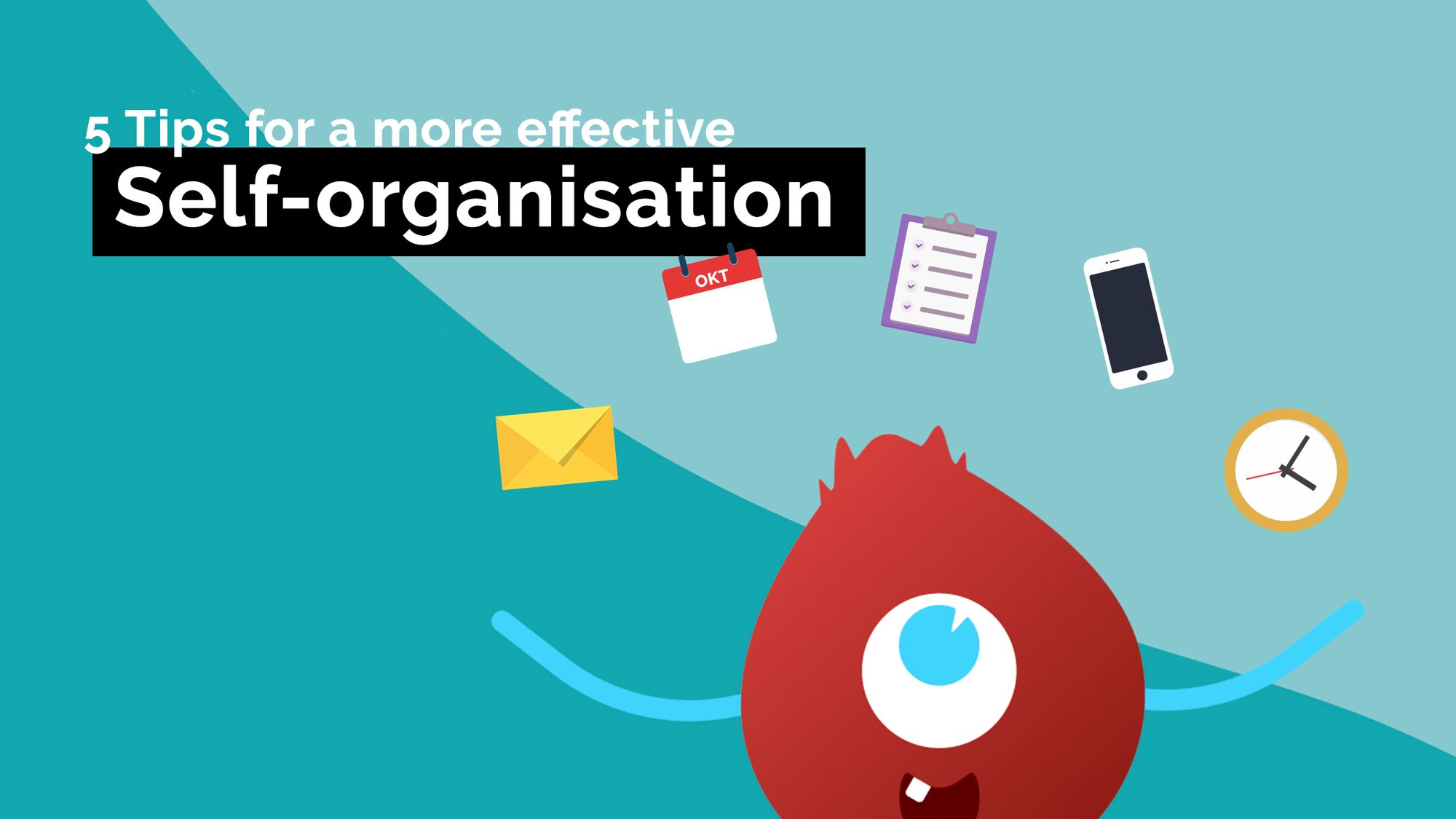2022-10-12 | Martin Grebner | 6 min read
5 Tips for a more effective self-organisation
Our Scandians share their experiences on how self-organizing ones daily work leads to more success. Follow our tips and bring more focus, clarity and motivation into your daily business.
A multitude of tasks lands on your to-do list. Some non-urgent topics pop up again and again for weeks and refuse to complete themselves or become obsolete. When you finally take on such a to-do, you're constantly interrupted – only to end up doing something else. And sometimes you just can't overcome the inner unwillingness because the work just seems too boring.
Trust us, we know these situations as well. The good news: Our agile experts developed a workshop format together with a diverse group of colleagues to tackle the issue. They share a series of best practices and their experience on how to to organize yourself more effectively. But before we start with these tips, however, here's a brief explanation of what self-organisation actually means.
The meaning of self-organisation
Self-organisation is not synonymous with a well-kept diary and a fancy to-do list. Rather, it is about individual structures that help to organize time, responsibility and work. These structures can exist, for example, at the level of an organisation to break down hierarchies. But also within a team it can be very useful to work out common procedures in a self-organized way.
On an individual level, self-organisation also means the structured organisation of one's own daily work routine – however, the procedures and contents sometimes differ significantly. The following tips refer to this individual level.

Tip 1: Get an overview
Often the sheer number of tasks is enough to make you feel stressed out. The result: You start with the first to-do without any further thoughts. Try to avoid this and get an overview instead:
- 📝 create and prioritize a to-do list directly in the morning or in the evening of the previous workday
- ⏱️ regularly schedule time to maintain the to-do list (if the effort for maintaining the list seems too high, there is probably a fundamental problem and another method must be used)
1. Create an unsorted task list (brainstorming)
2. Determine the most urgent and unpleasant task
3. Prioritize each task
4. Assess the workload (a rough estimate is sufficient)
5. Check your capacities
6. Set blockers and enter them in your calendar
7. Start
8. Reflect on the process and adjust if necessary
Tip 2: Cut out unimportant things
Your own work should feel fulfilling and contribute to the company's success in one way or another. However, this does not mean that you have to fulfill every task or every "wish" of your colleagues and managers.
- ❌ Learn to say "no" when your capacity is reached
- 👐 Delegate tasks
- ☑️ Stop starting, start finishing: Don't start (too) many different tasks at the same time; instead, focus on one task if possible and then finish it completely
Tip 3: Create focus
A working day is over much quicker than you think: Here a meeting, there a call and in between lunch with colleagues, from which new tasks arise. When should you actually complete your to-dos? The answer: Create focus times.
- 🕑 Reserve focus time (e.g. 2x a day, one hour focus time each, without calls or messenger notifications)
- 🔋 Know and leverage your own productive times:
→ productive phase = focus time (often morning & mid-morning).
→ less productive phase = meetings (often in the afternoon after lunch). - 📧 Open e-mails only twice a day and make an agreement on the time window in which inquiries will be responded to
- 🍅 If concentration is lacking it can help to use a time management method, for example the Pomodoro technique
The Pomodoro Technique is a time management method developed by Francesco Cirillo in the 1980s. The basic idea is to break down a larger task into small individual tasks and to work through these in 25-minute time intervals (the so-called pomodori). Each section is followed by a deliberate break time.
Dividing the work into 25-minute sections is done by using an alarm clock (or one of the many Pomodoro smartphone apps). Hence the name: The Pomodoro technique was named after a kitchen clock shaped like a tomato (in Italian pomodoro) that Cirillo used.
Tip 4: Get motivated & and just do it
Everyone has them, these unloved tasks you just keep procrastinating. We know it seems difficult, but take up the challenge and "eat that frog" - and treat yourself with a little reward once the work is done.
- 🐸 Eat that frog! Directly when prioritizing tasks, find out which task is the most urgent and also the most unpleasant one – and put it directly at the top of the list and preferably do it directly in the morning. This can give you a motivational kick first thing at the start of the day.
- 👯🏻 Find someone to complete the task together with
- ⚗️Analyze the task in more detail to find out what exactly is uncomfortable about it
- 👈 Maybe the same person works on the same task too often, then it should be better distributed within the team
- 🧁 reward yourself after a successful completion, for example with coffee/cake (of course only once in a while and only for absolute motivation killers 😉)
Tip 5: Do smart context switches
One's own to-do list often includes very different tasks, each with an other context. Accordingly, while working through the list, it is necessary to switch to a new context again and again. This constant familiarization with a new topic can sometimes be quite exhausting. We therefore recommend to:
- 🍴/🎧 Start a task with a different context after a meeting or lunch break
- ⏸️ Switch context when you have already been interrupted anyway
Quite simply: Because we work agile ourselves and offer consulting on the topic.
Scandio is not only a service provider for agile software development, but with the "Topic Agile" we also have a group of experts in the company who promote agile inside and outside our company. We work as Scrum Master or Product Owner in Scandio teams for customers and are involved in agile working, agile coaching and business development, especially related to agile software development, in external projects.
Internally, we share our knowledge across Scandio through blog posts and workshops. We also train employees specifically in agile methods through agile trainings.
The basic principle of Scandio itself is also based on self-organisation, trust and an agile mindset. That's why we mostly avoid hierarchies and replace positions with roles, processes and personal responsibility.
What does self-organisation look like in practice?
To illustrate what the tips mentioned mean in everyday work, let's take a simple example: We are supposed to write a blog post.
- Say no: Is the topic really relevant? If not, then maybe the blog post doesn't need to be written at all and the work time is better spent on another task.
- Define super-small steps after which you still see progress: find a headline, create the overall article structure, flesh out individual paragraphs, find images,....
- Small rewards after each step: when the article abstract is written, get a coffee in the kitchen or enjoy the sun for five minutes on the balcony, etc.
- Switch off perfectionism: The lead image doesn't have to be the very best, the very funniest. Better to have "just" a good picture instead of forever looking for the perfect one and never publishing the article.
- Get support to motivate each other: find a "fellow sufferer" and write the blog post togehter with someone.
- Set and communicate a deadline: announce the blog post to others.
- Complete the task as the first action of the work day: Write the blog post before your daily meeting.
Conclusion
Self-motivation is an essential factor for the success of self-organisation. If there is also a good overview, if focus can be created and working on different tasks is sensibly organized, nothing should stand in the way of a self-organized workday!
Our experienced Scrum Masters and Agile Coaches will be happy to help your business get started with agile project management. Contact us now.
And if you want to know why decision making methods are so important in the context of agile and which methods are available, read our article series: Decision Making in Agile Software Development.
Scandiolife on Instagram.
Connect with us on LinkedIn.
Look what Scandio is tweeting.



